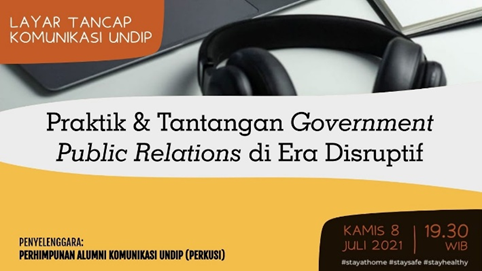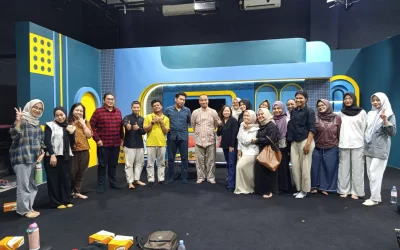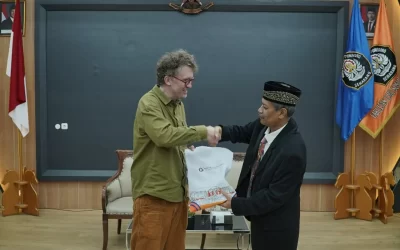The banner for the alumni discussion event “Plug-in Screen of Communication Undip” on Thursday, July 8, 2021, at 19.30.
(Image: Alumni Association of Communication Undip)
Semarang—Alumni Association of Communication Undip on Thursday, July 8, 2021, held an alumni discussion entitled “Layar Tancap Komunikasi Undip” online through the Zoom Meeting platform. The topic of discussion that was raised at this forum was “Practices and Challenges of Government Public Relations in the Disruptive Era”. This event was opened by Cicilia Sinabariba (alumni of class 2014) as MC and moderated by Heri Sagiman alumni of class 1994.
There are three main speakers in this event’s 1st Episode, namely Leidena Sekar Negari or Dena (Alumni of 2006 and Public Relations Officer of the Secretariat General of the DPR RI), Radityo Prabowo or Radit (Alumni of 2000 and Expert Staff of the Minister of Education and Technology), and Yosepha Indira Mafini or Vivien (Alumni of 1989 and Managing Director of Marygops Studios ). The three of them were given the opportunity to present their opinions for 15 minutes related to the themes and sub-themes raised.
Government Public Relations: Communication in Parliament
This topic is presented by Dena and begins by explaining that Government Public Relations (GPR) which works with government regulations and central government programs usually has a broad target or covers the entire community. The problem now is that the government’s performance is often too abstract so that it is not visible to the public. Although most of these programs look abstract, monitoring and evaluation must still be carried out.
“There are many changes in the public relations structure so that the communication pattern in the DPR RI has also changed from the initial Public Relations and News Bureau to the Parliamentary News Bureau, then changed again to the Protocol and Public Relations Bureau,” said Dena.
Dena said that currently, communication within the DPR RI is re-applying the concept of the Parliamentary News Bureau which emphasizes press releases, internal reporting, and official social media management and the Protocol and Public Relations Bureau which focuses on optimizing branding in the media.
“With the current state of affairs, all public relations programs in the DPR RI are carried out virtually. Therefore, the GPR in parliament undergoes changes and dynamics to be able to adapt in the disruptive era,” she added.
Communication Strategy in Kemendikbudristek
The second speaker, Radit, presented his opinion regarding the communication strategy within the Ministry of Education, Culture, Research, and Technology (Kemendikbudristek) where he worked. According to him, communication is positioned as a strategy, such as writing press releases, which can position government communication as disseminating carefully prepared program designs.
Radit also said that at Kemendikbudristek, he and his colleagues implemented issue and crisis communication management which consisted of three stages, namely pre, response, and post-program implementation to achieve good communication within the internal and external scope of the Kemendikbudristek.
“GPR in the Kemendikbudristek always strives for breakthrough PR events that still meet good broadcasting standards,” said Radit.
Government Campaign vs Brand Campaign
Vivien as the third speaker presented topics related to the campaign. According to her, along with the development of the era where currently all fields can take advantage of virtual technology, government campaigns are also constantly transforming, starting from channels and formats in government communications that switch to virtual forms. Vivien said it is important to create a target behavior before launching a campaign so that the campaign has a brand image.
Then, Vivien also explained the difference between the pre-disruptive era and the disruptive era. According to her, campaign targets in the pre-disruptive era will trust big-scale campaigns with narrative content and intelligent information, while in this disruptive era a target tends to trust information from peer groups, leaders in a group, influencers, or those whose closest to them.
“In a campaign we must master brand communication and integrated campaigns that prioritize community marketing, not to forget there are also various complementary aspects of forming a brand, namely community, channel, recruitment, target, activity, promotion, and a timeline,” concluded Vivien.
Writer: Dinda Khansa Berlian
Reporter: Sanita Sitinjak/Salsabila Febryanti





0 Comments